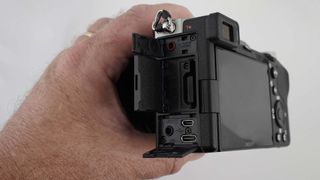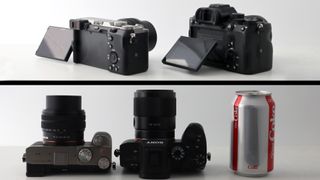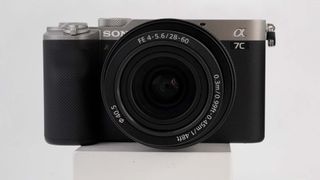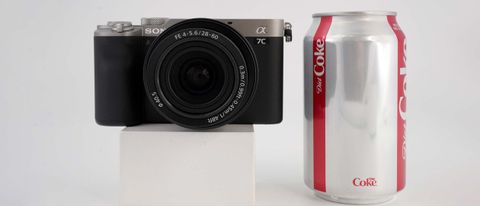Tom's Guide Verdict
The Sony A7C is a powerful, yet very portable full-frame camera that’s ideal for shooting travel, events or street photography.
Pros
- +
Tiny and lightweight body
- +
Powerful 5-axis in-body image stabilization
- +
Excellent battery life
- +
Versatile AF modes
- +
Flexible LCD
Cons
- -
Small EVF
- -
Lacks front dial and other controls
- -
Single memory-card slot
Why you can trust Tom's Guide
Image sensor: 24.2-MP full-frame CMOS
Image stabilization: 5-axis in-body image stabilization
Display: 3-inch LCD
ISO: 100-51,200 (expandable to ISO 50 and ISO 204,000)
Max video resolution: 4K / 3,840 x 2160 @ 30/24 fps
Ports: HDMI, USB, stereo mic and headphone jacks
Wireless/Bluetooth/NFC: Yes
Shooting speed: up to 10 fps
Battery life (CIPA): 740 shots
Size/weight (body): 4.9 x 2.8 x 2.2 inches; 18 ounces
Like so many new cameras right now, the Sony A7C is seemingly aimed primarily at vloggers and online content creators, AKA the people who make all of the videos we spend hours watching each day on YouTube and Instagram.
This group, according to Sony's research, want the powerful performance of a full-frame sensor, but in a small body. And they also want advanced features to make their lives easier when filming their latest masterpiece.
Well, the Sony A7C could be just what they're looking for — because it somehow crams a mighty full-frame sensor into a body that's far, far smaller than that of most rivals.
- Best photo editing software
- Save your images in the cloud with the best photo storage and sharing sites
In fact, Sony proclaimed on its launch last year that it was the smallest and lightest full-frame camera in the world. That's not strictly true — read the small print and you'll see that it's actually the smallest and lightest full-frame camera that also takes interchangeable lenses and that has in-body image stabilization — but there's no doubting that the A7C is an impressive feat of engineering.
As a result, it's likely to be of interest to a wider group than just vloggers. For instance, I could easily see it appealing to enthusiasts looking for a small camera to use as a second body, or amateurs who want to step up from a smartphone but who don't want the bulk of a DSLR.
At the same time, the A7C's small size has resulted in certain compromises being made. I spent some time with it to find out whether they're serious enough to count against it, and whether it's worthy of a place on our best mirrorless cameras list. Read on for the full Sony A7C review.
Sony A7C: Price and availability
The Sony A7C was unveiled in late 2020 with a price of $1,799 for the body-only version and $2,099 for its kit-lens configuration. Those prices are still in effect at the time of writing in July 2021.
You can also buy the kit lens, the new Sony FE 28-60mm f/4-5.6, as a standalone zoom for $498, making the kit-lens deal a good-value option if you don't already have a suitable chunk of glass to use with it.
Sony A7C review: Design and controls
Sony was always going to have to make some tough decisions with the A7C, because while its 24MP full-frame sensor is essentially the same as the one inside the A7 III, its body is considerably smaller.
Its solution was to remove some controls, such as the front dial and the joystick (which allows you to move the focus point, if that’s the AF mode you’re using). You can use the touchscreen to set the AF point, but some might miss that extra physical control. Unlike many full-frame cameras, it also includes just one memory card slot — not a fatal flaw, maybe, but still likely to be a frustration for some people.

What's more, the Sony A7C is also lumbered with an older menu structure compared to the one Sony introduced with the A7S III camera. Given the lack of controls, that's a further shame.
That said, there's much to like about the A7C's design. Obviously that small size is the most notable feature — and it really is very small for a full-frame camera. For comparison, I sat it next to my Sony A7R IV, with the A7C on the left of the image below.
In the top image, you can see the cameras from the back, at an angle, with their touch LCDs extended. In the bottom image, you can get a sense of the top controls. For both, the A7C had the new 28-60mm kit lens attached, and the A7R IV had the 35mm f/1.8 prime lens attached. (I also added the 12-ounce soda to give you an idea of the scale of each camera.)

Outside of its diminutive form, there are plenty of other nice touches about the A7C.
The swiveling touchscreen LCD, for instance, is a highlight; this swings out from the camera like a camcorder, making it easier to see what you're shooting in multiple different positions.
Sony also did a good job of designing a small-yet-capable 28-60mm zoom for the A7C kit. The firm's marketing department was at work again here, labeling it the “World’s smallest and lightest full-frame standard zoom lens,” and that may well be true: it weighs just 5.8 ounces.
That would mean nothing if it wasn't always a quality performer, of course, and fortunately is is: it did a good job shooting both photos and video, with its silent autofocus of particular note.
The one newly developed feature I didn’t like as much as the older versions was the compact eye-level viewfinder. A 2.36-million dot OLED EVF, it has a high enough resolution, but I wasn’t quite as comfortable looking through it as I am with the one on my Sony a7R IV. I suspect I’d be able to get used to it, over time, but I'd still prefer something slightly larger.
Sony A7C review: Image quality and video
Overall, the Alpha A7C produces very good to excellent images in bright light situations and normal shooting conditions — which is no less than you'd expect for a full-frame camera costing around the $2000 mark.
Whether I was shooting in bright sunlight or on an overcast day, the A7C's 24MP sensor performed very well, producing images with wide dynamic range and sharp, crisp details.
It's also pretty fast: I liked that it could capture 10 frames per second in burst mode, using either the shutter or in silent mode, and it packs a seriously impressive autofocus setup. I was particularly pleased that you have access to many of the same versatile AF modes as you get on other Sony Alpha full-frame cameras, including Real-time Eye AF (which can be set for animals, as well).

To make the body smaller, Sony needed to develop new versions of its built-in technology. For instance, they had to build a new IBIS system, which I felt worked just as well as in other cameras. They also needed to make a new compact shutter unit, which also worked as expected.
Like most cameras, though, it isn't quite so hot in low light. Increasing the ISO works well enough up to around ISO 12,800, but at that point you'll begin to see some image noise. This, in turn, will soften sharpness a bit, as well as introducing some tinted noise that will affect image quality.




In terms of video, the A7C is a little under-powered in some regards — surprising, given its target audience. While it shoots in 4K, it maxes out at 30 fps and it only hits that frame rate in a cropped mode; you'll need to step down to 24p to get full-width footage. There's no 10-bit recording, either — 8-bit is your max here.
Having said that, it only really suffers in comparison with more expensive full-frame models, and there's nothing wrong with the footage it shoots — in fact it's nice and sharp. The quality autofocus help here, too.
Sony A7C review: Battery Life / Wi-Fi, Bluetooth & NFC
The A7C has the same powerful battery, Sony's NP-FZ100, as the one that's used in other Alpha cameras. Here, it has a CIPA rating of 740 shots per charge when using the LCD or 680 shots when using the EVF.
It’s also well equipped to connect wirelessly, since it has built-in Wi-Fi, Bluetooth and NFC capabilities. In fact, it can use both 2.4 GHz and 5 GHz frequencies so you can send your images to a smartphone quickly and easily. For those looking for pro-level connectivity, the A7C can also use an FTP file transfer via wired and wireless LAN or employ USB tethering with a computer or smartphone.
Sony A7C review: Verdict

I’m sure there will be some people with larger-sized hands who may find the compact controls of the A7C a drawback. However, I’m sure most will enjoy carrying around something that isn’t as heavy as the average full-frame camera. Or rather, something that is considerably lighter than almost any other full-frame camera.
That small size does lead to some compromises, mainly in the lack of some controls that you'll find on other Sony Alpha cameras, but for most tasks, I found the A7C worked without a hitch.
Most importantly, image quality and autofocus performance are both excellent — there's a lot to like here. It's not exactly cheap, but if you're looking for full-frame performance in a compact body, the A7C should be high up your wish list.
- More: These are the best cameras right now
Terry Sullivan is an experienced technology journalist who has covered consumer electronics including cameras, smartphones, audio tech and software among many other things. His work has appeared in the likes of Consumer Reports, PCMag, Lifehacker, and the New York Times and he is also a teacher, photographer, artist, and musician.
